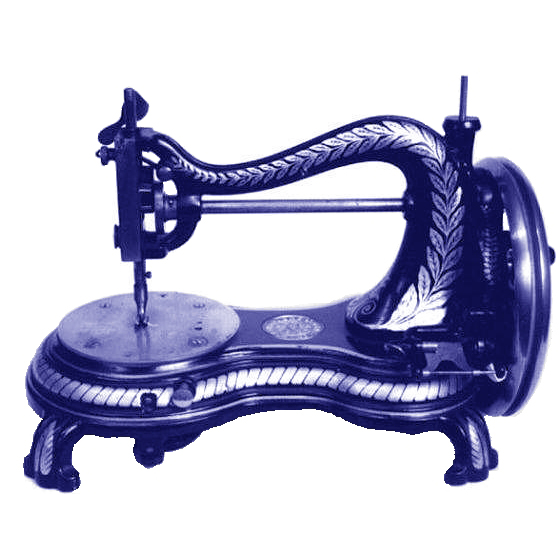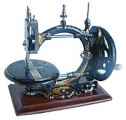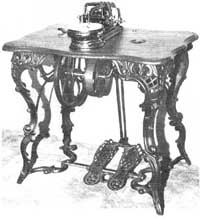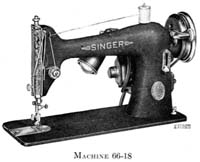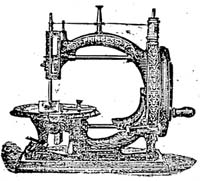Carry on baggage or How to travel with a sewing machine
If you subscribe to, and are a regular reader of, any of the online digests you may notice that the topic of transporting sewing machines sometimes comes up for discussion. A little more than a year ago on the Featherweight Fanatics list this was the case. I clearly remember because I was about to be faced with this very challenge.
I had pretty much worn out my day-to-day sewing machine, a 22-year-old electronic New Home 6000. Unfortunately it had too many plastic parts - none of which could be replaced (I think this is called planned obsolescence). This poor machine had, quite literally, sewn its little feet off. At this point I needed to do some research and buy a new sewing machine.
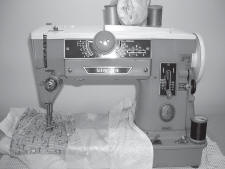
fig 1
After telling mom my tale of woe, it was agreed that we should do some "sewing machine shopping" while I was visiting her in Florida. Since my vacation was coming up in a couple of weeks, it made sense to use the time to learn about what was "out there" and what I might like. I told mom that I was hoping there were new machines like hers; machines that were designed to be workhorses (for real sewing) but had some nice features like buttonhole attachments and some design stitching options.
A few days later the phone rang. It was mom. She explained that she had decided to let me take her sewing machine home with me. Mom went on to tell me that she rarely used her machine anymore and in the Florida humidity it needed to be kept well oiled & clean whether it was used it or not. To her this had become a big job that she no longer wanted to do, and as she put it, "for value received" the machine was too much work.
Now, my job was to figure out how get my mother's Singer 401A from Florida to New Hampshire without damage. Since I was going to be flying down & back, I had to figure out the best way to transport this thing. Luckily, as I said earlier, the FWF group had just gone round on this very subject. Now, my mother's 401A is not anywhere near as light and compact as a featherweight, but this machine was just as fragile and needed to be handled with equal care.
The first hurdle was determining if the carry case was within the regulation carry-on size restrictions imposed by the airline. Since mom doesn't have a computer, we decided to call the toll free customer service number and get the carry-on dimensions. Here we encountered our first problem. We got an agent who could not tell us their carry-on luggage dimensions but would be happy to assist us with anything else we may need. Turns out, we never did figure out exactly what it was she could do to help. Next, I make my first trip to the local library to use their computers and check for myself. After much hunting around, I stumbled on an obscure page with baggage information. The dimensions were there but they were buried somewhere within information about child restraint seats, excess baggage, and personal items. Fortunately, it appeared that the case qualified as carryon baggage.
Since I did not know if the sewing machine and carry case would exceed any weight limitations for carry-on baggage, I decided to pack the machine (as best I could) as though it were going to be shipped through as checked luggage. My mother lives in a very small home in an elderly housing community, so my packing material of choice was, oddly enough, old towels and fabric. The goal was to make the machine as snug inside the case as possible so as to limit any kind of movement. So, basically, I decided to mummify it.
Before wrapping the machine in any protective toweling, I began by securing any parts and pieces that were protruding or could possibly be snapped or bent. This meant protecting the spool pins with old wooden spools of thread and placing a rolled piece of toweling between the 2 spools on top of the machine to keep them upright. Next, I took some old material and put down the presser foot, and lowered the needle entirely. Everything else appeared secure enough to be protected by the towel wrapping. (fig 1)
Each time I wrapped a different part of the machine I had to place the machine inside the case to make sure it fit properly. This towel wrapping procedure required a lot of towel cutting, wrapping, and taping, along with an equally laborious number of fit trials. I wanted to be absolutely certain that nothing on the machine was bent, rubbing, or too loose. (fig 2)
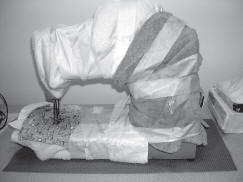
fig 2
I also chose to pack the attachment box, instructions, bobbin box, and presser foot inside the case with the machine. Since the bobbin box & attachment boxes had loose items inside, I decided to stuff them with paper toweling to minimize any rattling that might draw unnecessary attention. Each box was then put into a plastic newspaper/bread bag and tied shut.
When I was finally satisfied that the machine and all it's related components were safely packed inside the carry case, it was time to roll and stuff the remaining spaces with towels and fabric. As you can see, fabric makes ideal packing material. It can be folded and rolled to fit any configuration. A few of my mom's neighbors heard about the project and came by to see if they could help. Fortunately, I was really lucky to have enough packing material as many of the neighbors donated fabric for this little project. Actually, I had so much material that I couldn't use it all! I must confess that I did take home all the extra fabric rather than hurt anyone's feelings by trying to give it back.
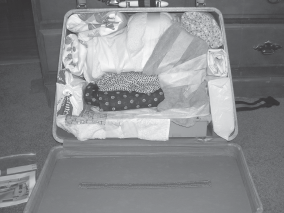
fig 3
Once the machine was safely ensconced within it's carry case, the next order of business was to insure that the case would not accidentally come open should the latches break or be compromised. We considered a number of options and finally settled on a simple adjustable strap with a pinch latch mechanism. This was to facilitate opening the case in the event of an inspection. It was also suggested, on the FWF digest, that there be a securely attached tag that clearly states: SEWING MACHINE. Another suggestion was that there be an attached picture of the contents. I went with both ideas. The yellow tag gives my name, address, and phone number on one side, and the reverse side says SEWING MACHINE in black indelible marker. There is a zip-lock bag with a photo of the sewing machine also attached. (fig 4)
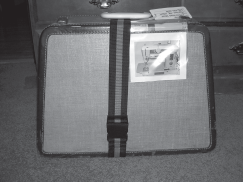
fig 4
The final piece of this puzzle was how to effectively carry this suitcase across the airport terminal, through security, and down to the assigned gate. This thing was HEAVY . Leave it to an 80 year-old woman, who is about 100 pounds soaking wet with shoes on, to come up with the solution. Mom watched patiently as I huffed, and puffed, and struggled to devise a way to transport this beast. After a bit, she quietly suggested something like: "Why don't you just get one of those collapsible wheeled carts, dear?" A quick trip to the local thrift store yielded a lovely, inexpensive, collapsible handcart that has been extremely handy on more than one occasion since then. Definitely money well spent.
At last the day of departure had arrived. I was all set to explain my unusual bag, empty the contents for inspection, and beg to have it travel on my lap if need be. The only two check points of real concern for me were the actual baggage screening area and at the gate during actual boarding. The X-ray screening went well, although it raised a few eyebrows and required a couple of additional screeners to be sure of the contents. At the gate I was not flagged for a random inspection and simply boarded without incident until I was onboard and ready to take my seat. It was then that the flight attendant asked me to put the machine in the overhead bin. Now, I do go to the gym and work out, but there was no way that I was going be able to lift this machine over my head and place it in a bin. It was simply too heavy.
I was all set to quietly slip into my seat and wedge it under my feet, when a nice gentleman offered to place it above. Again, my stomach did a flip-flop because I was sure that the man would suffer a medical emergency and that the attendant would insist that the machine fly cargo. Fortunately, the man easily lifted it into the overhead bin. Now, I had a new worry. How was I going to get this thing down without suffering a concussion or worse yet, break the machine into little pieces? I should not have worried though, another unsuspecting gentleman offered to remove from the overhead. How could I say no?
